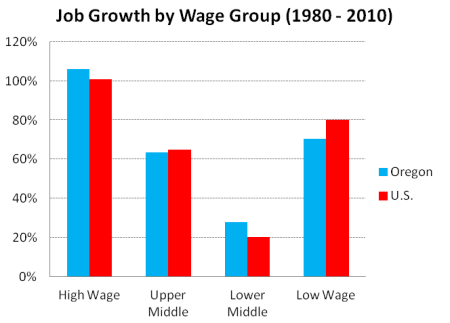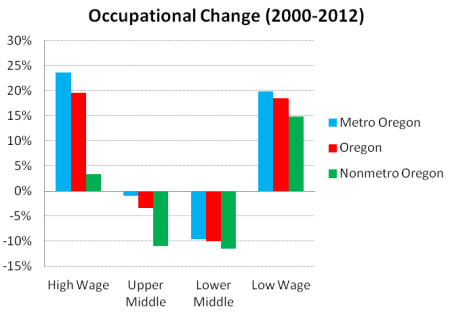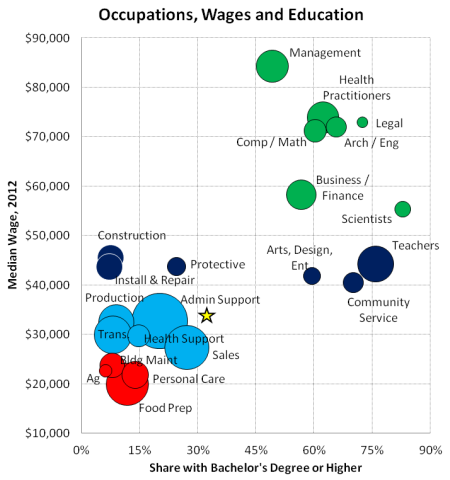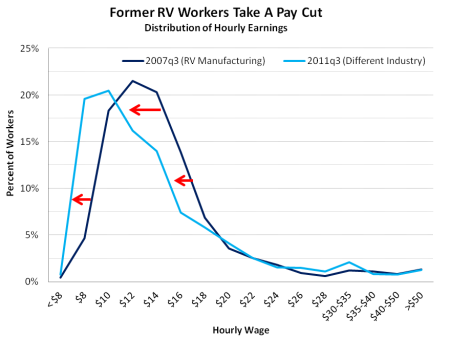The following is a brief overview of our office’s new research report: Job Polarization in Oregon. There are many interesting details and nuggets of information in the report, and we highly encourage you to read the whole thing to learn more about how job polarization is impacting the economy.
Click Here to Download the Report
Click Here to Download the Slides
Job polarization — the process of shrinking opportunities for middle-wage jobs, with growth concentrated at the high and low ends of the spectrum — has been shaping the national and local labor market for decades. Since 1980, Oregon has polarized in-line with the average state, however we have done a little bit better in terms of high-wage jobs and lower middle-wage jobs.
In particular, Oregon’s employment growth, and job polarization, has varied considerably by decade. The early 1980s recession, which was very severe locally, impacted growth during that decade, along with the absolute and relative decline of the timber industry in the state in the past 30 years. In the 1990s, growth across the board was strong and Oregon was able to stem the polarization tide. However in the 2000s, middle-wage jobs suffered more than in most other states, with growth heavily concentrated at the high and low ends. As shown previously, employment growth during and after the Great Recession has exacerbated the job polarization trends and nearly all job growth in the past two years has been either high- or low-wage. Please see the report for a more complete discussion on these patterns.
Another important aspect to job polarization in Oregon has been the relative changes in the state’s metropolitan areas compared with the rest of the state. Overall job polarization has been more pronounced in Metro Oregon since 2000. However, nearly all of the high-wage job gains have occurred in Metro Oregon as well. Rural Oregon has seen the loss of many middle-wage jobs over the past 12 years, with employment growth heavily concentrated in low-wage occupations.
What can be done about polarization? The first answer one hears is usually: education, education, education. And that’s right to a certain degree. Overall there is a high correlation between educational attainment and wages, however it is not a perfect one. As seen below there is considerable variation in wages among similar educational groups but also considerable variation in educational attainment among similar wage groups. For example, Teachers and Construction workers get paid approximately the same even though they have substantially different formal education requirements. Additionally, Management — the highest paid — has the lowest educational attainment of the high-wage occupations.
Earning a four year degree is the most likely path to obtaining a job in one of the high paying occupations. However a college degree is not be-all and end-all, particularly for the upper middle-wage jobs. There are also differences between high school degrees and some college education for the lower middle and low-wage jobs. See the report for a discussion on the implications for each type of job, what is the underlying economic driver for these different wage groups, the impacts of job polarization on them and also what it means going forward.
Finally, it is important to remember that these labor market transformations are not costless. The process of job polarization does displace workers. Although the remaining workers are more productive, those most impacted face a tough transition to obtaining another job, particularly if it requires retraining in a new field. A microcosm of the negative side effects of job polarization is the RV industry in Oregon. Based on research by the Oregon Employment Department, and discussed previously on the blog, workers who were able to find another job in Oregon after leaving the RV industry, faced a considerable downward shift in wages. These events, where a worker loses a middle-wage job and replaces it with low-wage work is the bad type of polarization.
Much more information and a more complete discussion of these trends can be found in the report.




[…] Our Job Polarization in Oregon report focused on trends at the state level and had some discussion on the urban-rural split in job growth, however these processes can be experienced and observed even down to the neighborhood level. Examining such changes — polarization, economic sorting, integration/segregation — is very interesting and with another year or two of ACS data, we can get good numbers locally as well to compare pre-recession and post-recession trends. This also has been shown to have big implications for economic mobility, as discussed previously. In the future, we hope to work on producing such maps once more data becomes available. […]
By: Salem Polarization Maps | Oregon Office of Economic Analysis on December 2, 2013
at 8:48 AM
[…] not all of this education and training necessarily has to be in the classroom, as discussed in our Job Polarization in Oregon report. Many of the upper middle-wage jobs (construction, installation, maintenance and repair, […]
By: Education and Labor Force, Pt 1 | Oregon Office of Economic Analysis on December 11, 2013
at 9:29 AM
[…] than the state overall. Plus a lower relative share of low-wage jobs. These trends are part of the overall job polarization process, part of which is the creation of high-wage jobs predominately in metropolitan areas. While no […]
By: Portland Metro | Oregon Office of Economic Analysis on December 23, 2013
at 9:46 AM
[…] varies across occupations as well, so just as job polarization impacts employment and economic growth, it likewise has an impact on patterns of consumer spending, which does include […]
By: Oregon, Alcohol and Demand | Oregon Office of Economic Analysis on March 21, 2014
at 11:18 AM
[…] New occupational data for 2013 was just released by the Bureau of Labor Statistics. Overall 2013 was not only stronger than previous years, since we already knew job growth accelerated, but the pattern of growth across occupations was also more encouraging. Below is an update on job polarization in Oregon, following the same methodology and sources as our research report last year. […]
By: Update: Job Polarization in 2013 | Oregon Office of Economic Analysis on April 2, 2014
at 10:09 AM
[…] official unemployment rate, with good reason. Hours worked were cut, the job ladder is/was broken, job polarization pushes some into underemployment and the like. Besides, the unemployment rate can go up for good […]
By: Estimating Historical U-6 in Oregon | Oregon Office of Economic Analysis on May 14, 2014
at 9:57 AM
[…] when looking at the occupations by wage group, the pattern of job polarization is also apparent. In the first graph, the high-wage (green) occupations are generally easy to fill […]
By: Structural Unemployment and Underqualified Applicants | Oregon Office of Economic Analysis on July 1, 2014
at 9:53 AM
[…] discussions on the economy revolve around employment (industries, job polarization, etc) or the unemployment rate (with some discussion on short- vs long-term unemployed) but rarely […]
By: Graph of the Week: Unemployment and Job Polarization | Oregon Office of Economic Analysis on July 30, 2014
at 10:20 AM
[…] jobs that pay enough to cover even a scaled-down version of the middle-class purchase list. A report by the Oregon Office of Economic Analysis last year detailed the decline of middle-class jobs, especially traditional blue-collar jobs. Those […]
By: Labor Day speeches should focus on middle-class opportunity: Editorial | Business News on September 1, 2014
at 12:49 PM
[…] one important aspect are wages. As discussed in our office job polarization report last fall, not only have wood product jobs, and the forest sector more broadly, fallen by half to […]
By: Changing of the Guard | Oregon Office of Economic Analysis on September 4, 2014
at 10:47 AM
[…] economy and our office tries to provide the full picture when available. For example, our work on job polarization showed that the economy was not just adding low-wage jobs, but also lots of high-wage ones as well. […]
By: Jobs, Population and Unemployment | Oregon Office of Economic Analysis on October 21, 2014
at 9:49 AM
[…] wage gains are happening more at the top and bottom ends of the labor market. As our office has detailed before, job polarization is impacting the labor market, particularly in terms of the number and availability of jobs. […]
By: Oregon Wage Growth by Industry and County | Oregon Office of Economic Analysis on December 9, 2014
at 9:55 AM
[…] with the economy in recent years, including the long-term unemployed, the urban-rural divide and middle-wage jobs. To take the analysis a step further, our office is introducing the Economic Recovery Scorecard […]
By: Economic Recovery Scorecard | Oregon Office of Economic Analysis on January 7, 2015
at 10:48 AM
[…] the much-discussed category of middle-wage jobs as follows, based on our job polarization work (see full report, see short update.) It is important to point out that this analysis focuses on occupations and not […]
By: 2015 Outlook: Middle-Wage Jobs | Oregon Office of Economic Analysis on January 13, 2015
at 1:05 PM
[…] in the near future. See the Federal Reserve Bank of New York and/or our office’s previous report on job polarization in Oregon for a good start on state level analysis, for those […]
By: Update on Job Polarization | Oregon Office of Economic Analysis on March 25, 2015
at 1:01 PM
[…] is the impact on jobs. Oregon’s labor market is polarizing at the same rate as the nation. Our transportation jobs have seen more negative trends, however our […]
By: Oregon Exports, Trade and Growth | Oregon Office of Economic Analysis on April 8, 2015
at 9:39 AM
[…] measures like the Economic Recovery Scorecard, the Total Employment Gap, and job polarization (e.g. HERE, HERE, […]
By: As Good as it Gets? | Oregon Office of Economic Analysis on April 21, 2015
at 9:31 AM
[…] the quality of Oregon’s job growth in recent years. This continues our office’s work on job polarization — the fact that much of the job growth is concentrated in both the high- and low-end of the […]
By: Job Growth Quality, Oregon Edition | Oregon Office of Economic Analysis on April 23, 2015
at 10:33 AM
[…] larger losses among the so-called middle-wage or middle-skill jobs than the typical state. As our office’s report pointed out, Oregon’s labor market is polarizing at roughly the same rate as the nation, or […]
By: State Labor Markets, Sneak Peek | Oregon Office of Economic Analysis on May 7, 2015
at 10:05 AM
[…] on the quality of Oregon’s job growth in recent years. This continues our office’s work on job polarization — the fact that much of the job growth is concentrated in both the high- and low-end of the wage […]
By: Job growth quality | Oregon Tax News on September 21, 2015
at 7:17 AM
[…] the types or quality of those jobs. There are always winners and losers over the business cycle. Job polarization continues, even as middle-wage jobs are starting to pick up a little. Big service sector industries […]
By: Jobs and Population Growth | Oregon Office of Economic Analysis on September 22, 2015
at 9:58 AM
[…] knew that the economy in Oregon was growing at full-throttle rates, which combined with job polarization meant that many high-wage jobs were being created. Particularly in the nation’s largest […]
By: Portland Household Growth by Income (Housing) | Oregon Office of Economic Analysis on October 7, 2015
at 9:05 AM
[…] that pay roughly $30-50,000 per year — based on our office’s job polarization research (HERE & HERE, e.g.) — and represents the middle part of the income distribution, and employ […]
By: 2016 Outlook: Labor Force Participation and Middle-Wage Jobs | Oregon Office of Economic Analysis on December 29, 2015
at 9:22 AM
[…] Middle-wage jobs account for a declining share of the overall economy in recent decades. See our office’s 2013 report for a more thorough and complete […]
By: Oregon Job Polarization Update 2015 | Oregon Office of Economic Analysis on March 30, 2016
at 1:51 PM
[…] as a share of the economy and in the outright number of such jobs. Of course we have known about job polarization and its impact on the Oregon economy for some time now. However, the losses of blue collar jobs is particularly pronounced among this […]
By: Prime Working Age Oregon Males | Oregon Office of Economic Analysis on June 28, 2016
at 1:39 PM
[…] that is generally not discussed as much: their impact on women. Whenever I give a presentation on our office’s state level job polarization work, I always talk about Mad Men. In the office scenes of the show, there is always one administrative […]
By: Office Support Decline Rivals Manufacturing | Oregon Office of Economic Analysis on July 7, 2016
at 10:00 AM
[…] first place to start when talking about the changing economy and lackluster trends would be our office’s 2013 report: Job Polarization in Oregon. Since it’s publication we have provided short, annual updates, and others have followed with […]
By: Economic Anxiety in Oregon, A Summary | Oregon Office of Economic Analysis on November 9, 2016
at 1:14 PM
[…] with meager trends among middle-wage jobs — has been shaping the economy for decades. See our report Job Polarization in Oregon for a more thorough […]
By: City Club of Portland (Video and Research Links) | Oregon Office of Economic Analysis on January 10, 2017
at 1:40 PM
[…] is a brief update on polarization in the U.S. Next week I will dive into the state level data. See our office’s 2013 report for a more thorough and complete […]
By: Job Polarization, 2016 Update | Oregon Office of Economic Analysis on March 31, 2017
at 8:32 AM
[…] is a brief update on polarization in the U.S. Next week I will dive into the state level data. See our office’s 2013 report for a more thorough and complete […]
By: Job Polarization, 2016 Update | Oregon Office of Economic Analysis | eClips on March 31, 2017
at 12:44 PM
[…] there is a whole lot more to add in terms of the narrative. Please see last week’s post and our previous report for a more complete look. As such, I’ll get straight to the […]
By: Job Polarization in Oregon, 2016 Update | Oregon Office of Economic Analysis on April 6, 2017
at 9:35 AM
[…] think there is a whole lot more to add in terms of the narrative. Please see last week’s post and our previous report for a more complete look. As such, I’ll get straight to the […]
By: Job Polarization in Oregon, 2016 Update | eClips on April 6, 2017
at 11:10 AM
[…] post was an updated and modified excerpt from our office’s original Job Polarization in Oregon report. I pulled this information for two reasons. First, as mentioned the other day, I am updating […]
By: Occupations, Wages, and Educational Attainment | Oregon Office of Economic Analysis on January 11, 2018
at 1:15 PM
[…] which pay roughly $35,000 – $50,000 for the typical worker in 2017. As we detailed in our office’s 2013 report, middle-wage jobs can be broken down into those which are more population-driven and those which […]
By: Oregon Job Polarization, 2017 Update | Oregon Office of Economic Analysis on April 3, 2018
at 10:13 AM
[…] stagnation and decline of production jobs in Oregon and across the country is a problem. See our job polarization report for more. Second, a good chunk of the trends above can be explained by what our office calls The […]
By: Manufacturing’s Evolution (Timber- and Tech-Related) | Oregon Office of Economic Analysis on January 23, 2019
at 1:30 PM
[…] in recent decades there has been a decline in these types of jobs due to job polarization. As is well known, these changes have impacted traditional blue-collar, male dominated occupations […]
By: Urban Wage Premium, Pacific Northwest Edition | Oregon Office of Economic Analysis on March 20, 2019
at 10:00 AM
[…] I’m not here to rehash all of the job polarization research (see HERE, HERE, HERE, and HERE for starters) but to provide an update based on the recently released 2018 […]
By: Middle-Wage Jobs Are Almost Back (2018 Job Polarization Update) | Oregon Office of Economic Analysis on April 12, 2019
at 9:06 AM
[…] is not the be-all and end-all of a good paying job. Nor is it the only measure of skill. See our report on job polarization and our dive into occupations, wages, and education for a more thorough discussion. That said, we […]
By: Big Question #2: Capital and Long-Run Growth | Oregon Office of Economic Analysis on October 30, 2019
at 10:45 AM
[…] skills are learned more on the job than in the classroom on a college campus. Furthermore, from a job polarization perspective, these manual, non-routine occupations are hard to automate and their outlooks are tied not to […]
By: Young Oregonians and the Trades | Oregon Office of Economic Analysis on February 25, 2020
at 9:41 AM
[…] the highest nationwide, had a lot of these wealth work jobs. Overall the research fits into the job polarization trends the U.S. economy experienced in the 2000s and […]
By: Scenic Areas, Wealth, and Industrial Structure | Oregon Office of Economic Analysis on August 3, 2023
at 9:57 AM